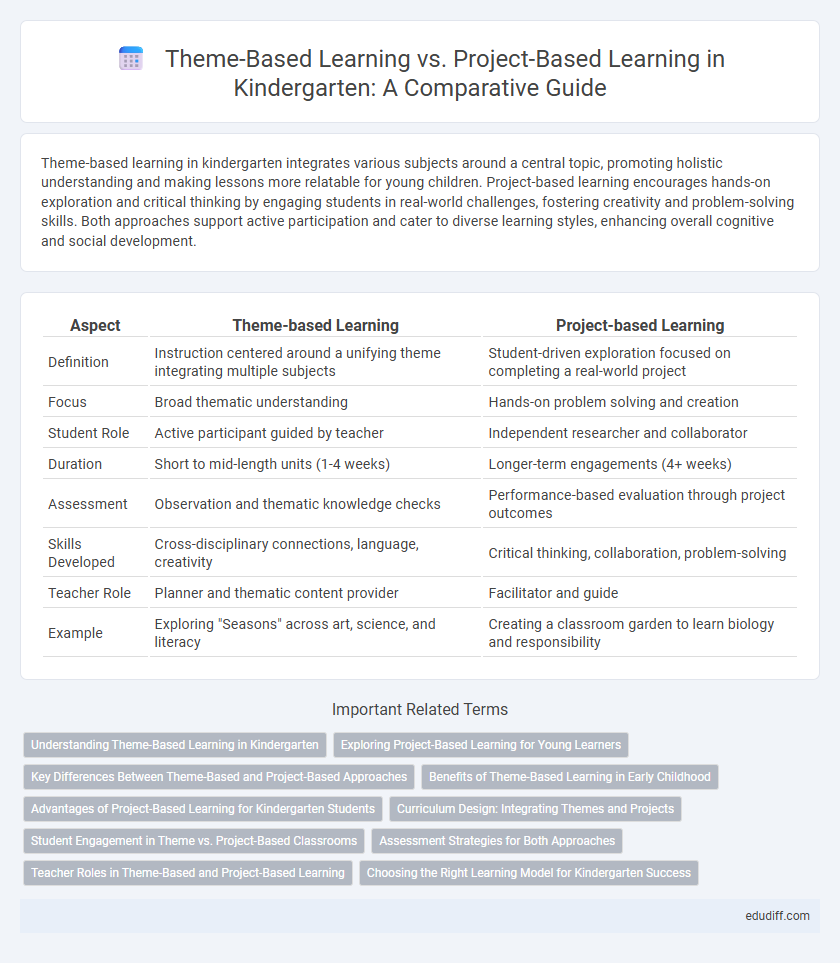Theme-based learning in kindergarten integrates various subjects around a central topic, promoting holistic understanding and making lessons more relatable for young children. Project-based learning encourages hands-on exploration and critical thinking by engaging students in real-world challenges, fostering creativity and problem-solving skills. Both approaches support active participation and cater to diverse learning styles, enhancing overall cognitive and social development.
Table of Comparison
| Aspect | Theme-based Learning | Project-based Learning |
|---|---|---|
| Definition | Instruction centered around a unifying theme integrating multiple subjects | Student-driven exploration focused on completing a real-world project |
| Focus | Broad thematic understanding | Hands-on problem solving and creation |
| Student Role | Active participant guided by teacher | Independent researcher and collaborator |
| Duration | Short to mid-length units (1-4 weeks) | Longer-term engagements (4+ weeks) |
| Assessment | Observation and thematic knowledge checks | Performance-based evaluation through project outcomes |
| Skills Developed | Cross-disciplinary connections, language, creativity | Critical thinking, collaboration, problem-solving |
| Teacher Role | Planner and thematic content provider | Facilitator and guide |
| Example | Exploring "Seasons" across art, science, and literacy | Creating a classroom garden to learn biology and responsibility |
Understanding Theme-Based Learning in Kindergarten
Theme-based learning in kindergarten integrates multiple subject areas around a central topic, enhancing children's cognitive connections and retention. This approach promotes language development, critical thinking, and social skills by engaging students with relevant, real-world concepts in a structured yet flexible framework. Educators observe improved student motivation and deeper comprehension as children explore themes through diverse activities tailored to various learning styles.
Exploring Project-Based Learning for Young Learners
Exploring project-based learning in kindergarten enhances critical thinking and collaboration by engaging young learners in hands-on activities tied to real-world themes such as seasons, animals, and community helpers. Unlike theme-based learning, which structures content around broad topics, project-based learning encourages inquiry, creativity, and problem-solving through student-driven projects that integrate multiple domains like literacy, math, and science. This approach supports developmental milestones by fostering autonomy, communication skills, and practical knowledge application in early childhood education.
Key Differences Between Theme-Based and Project-Based Approaches
Theme-based learning in kindergarten centers on exploring interconnected concepts within a specific topic, enhancing vocabulary and cognitive associations. Project-based learning engages children in hands-on activities to solve real-world problems, promoting critical thinking and collaboration skills. Key differences include theme-based learning's emphasis on content integration and project-based learning's focus on practical application and skill development.
Benefits of Theme-Based Learning in Early Childhood
Theme-based learning in early childhood enhances cognitive development by providing structured, interconnected concepts that help children make meaningful connections across subjects. It improves language acquisition and vocabulary by immersing children in relevant, context-rich environments that stimulate curiosity and communication skills. This approach also fosters social-emotional growth through collaborative activities centered around familiar and engaging themes, supporting positive peer interactions and emotional regulation.
Advantages of Project-Based Learning for Kindergarten Students
Project-based learning in kindergarten fosters critical thinking and problem-solving skills by engaging students in hands-on, meaningful activities linked to real-world contexts. It encourages collaboration and communication, enhancing social development and emotional intelligence through teamwork and shared goals. This approach also promotes creativity and independence, allowing young learners to take ownership of their learning process and deepen understanding through exploration.
Curriculum Design: Integrating Themes and Projects
Kindergarten curriculum design benefits from integrating theme-based and project-based learning by creating immersive experiences that promote critical thinking and creativity. Themes provide a structured framework around topics like seasons or animals, while projects enable hands-on exploration and problem-solving within those themes. Combining these approaches enhances cognitive development and supports diverse learning styles through meaningful, real-world applications.
Student Engagement in Theme vs. Project-Based Classrooms
Theme-based learning in kindergarten promotes consistent student engagement by providing familiar, interconnected topics that encourage exploration and curiosity over time. Project-based learning fosters hands-on involvement through real-world challenges, enhancing critical thinking and collaboration skills as children actively create and problem-solve. Both methods boost participation, but theme-based environments sustain engagement through continuity, while project-based settings stimulate dynamic, goal-oriented interaction.
Assessment Strategies for Both Approaches
Theme-based learning assessments in kindergarten often utilize observational checklists and portfolios to gauge students' understanding of integrated concepts across subjects. Project-based learning assessment strategies emphasize performance tasks, peer evaluations, and presentations to measure practical application, collaboration skills, and problem-solving abilities. Both approaches benefit from formative assessments that provide ongoing feedback to support individual developmental progress and learning outcomes.
Teacher Roles in Theme-Based and Project-Based Learning
In kindergarten, teachers in theme-based learning guide students by providing structured content tied to specific themes that integrate multiple subject areas, fostering curiosity through planned activities. In project-based learning, teachers act as facilitators who encourage exploration and problem-solving, supporting children's interests and collaboration while allowing flexibility in learning pathways. Both approaches require teachers to adapt their roles to promote engagement, creativity, and critical thinking aligned with the developmental needs of young learners.
Choosing the Right Learning Model for Kindergarten Success
Theme-based learning in kindergarten fosters holistic development by integrating subjects around a central topic, enhancing retention and engagement through relevant, age-appropriate content. Project-based learning promotes critical thinking and problem-solving skills by encouraging hands-on exploration and collaboration on real-world challenges. Selecting the right learning model depends on balancing curriculum goals with children's developmental needs, ensuring both cognitive growth and social-emotional learning in early childhood education.
Theme-based Learning vs Project-based Learning Infographic

 edudiff.com
edudiff.com